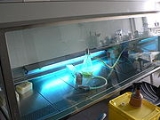
Laminar flow cabinet
Encyclopedia
A laminar flow cabinet or laminar flow closet or tissue culture hood is a carefully enclosed bench designed to prevent contamination of semiconductor wafers, biological samples, or any particle sensitive device. Air is drawn through a HEPA
filter and blown in a very smooth, laminar flow
towards the user. The cabinet is usually made of stainless steel
with no gaps or joints where spores might collect.
Such hoods exist in both horizontal and vertical configurations, and there are many different types of cabinets with a variety of airflow patterns and acceptable uses. NSF49 is the commonly accepted regulatory standard for these cabinets.
Laminar flow cabinets may have a UV-C germicidal lamp
to sterilize the shell and contents when not in use. (It is important to switch this light off during use, as it will quickly give any exposed skin sunburn
and may cause cataracts.)
HEPA
High-Efficiency Particulate Air or HEPA is a type of air filter. Filters that are awarded the HEPA accolade are used in various locations, whether in medical facilities, automotive vehicles, airplanes, home filters, or wherever very pure air is sought. The filter must satisfy certain standards of...
filter and blown in a very smooth, laminar flow
Laminar flow
Laminar flow, sometimes known as streamline flow, occurs when a fluid flows in parallel layers, with no disruption between the layers. At low velocities the fluid tends to flow without lateral mixing, and adjacent layers slide past one another like playing cards. There are no cross currents...
towards the user. The cabinet is usually made of stainless steel
Stainless steel
In metallurgy, stainless steel, also known as inox steel or inox from French "inoxydable", is defined as a steel alloy with a minimum of 10.5 or 11% chromium content by mass....
with no gaps or joints where spores might collect.
Such hoods exist in both horizontal and vertical configurations, and there are many different types of cabinets with a variety of airflow patterns and acceptable uses. NSF49 is the commonly accepted regulatory standard for these cabinets.
Laminar flow cabinets may have a UV-C germicidal lamp
Germicidal lamp
A germicidal lamp is a special type of lamp which produces ultraviolet light . This short-wave ultraviolet light disrupts DNA base pairing causing thymine-thymine dimers leading to death of bacteria on exposed surfaces...
to sterilize the shell and contents when not in use. (It is important to switch this light off during use, as it will quickly give any exposed skin sunburn
Sunburn
A sunburn is a burn to living tissue, such as skin, which is produced by overexposure to ultraviolet radiation, commonly from the sun's rays. Usual mild symptoms in humans and other animals include red or reddish skin that is hot to the touch, general fatigue, and mild dizziness. An excess of UV...
and may cause cataracts.)

